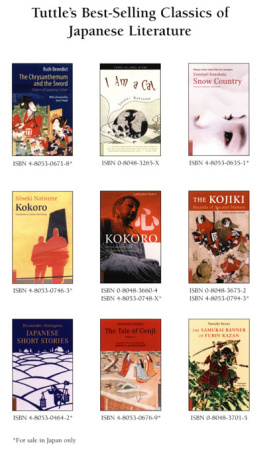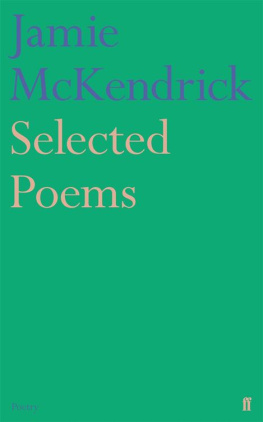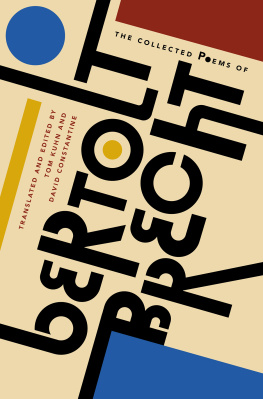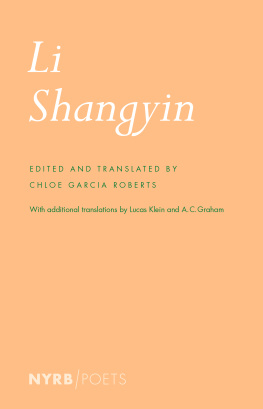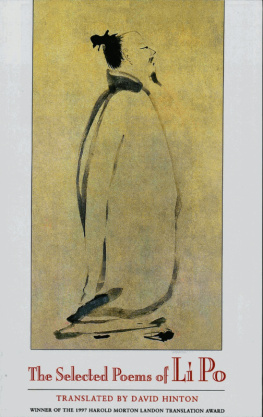Zen Poetry
BOOKS BY LUCIEN STRYK
Taproot
The Trespasser
Zen: Poems, Prayers, Sermons, Anecdotes, Interviews
Notes for a Guidebook
Heartland: Poets of the Midwest
World of the Buddha: An Introduction to Buddhist Literature
The Pit and Other Poems
Afterimages: Zen Poems of Shinkichi Takahashi
Twelve Death Poems of the Chinese Zen Masters
Zen Poems of China and Japan: The Cranes Bill
Awakening
Heartland II: Poets of the Midwest
Three Zen Poems
Selected Poems
Haiku of the Japanese Masters
The Duckweed Way: Haiku oflssa
The Penguin Book of Zen Poetry
The Duckpond
Prairie Voices: Poets of Illinois
Zen Poems
Encounter with Zen: Writings on Poetry and Zen
Cherries
Bird of Time: Haiku of Basho
Willows
Collected Poems 19531983
On Love and Barley: Haiku of Basho
Triumph of the Sparrow: Zen Poems of Shinkichi Takahashi
Bells of Lombardy
Of Pen and Ink and Paper Scraps
The Dumpling Field: Haiku of lssa
The Gift of Great Poetry
Cage of Fireflies: Modern Japanese Haiku
Zen, Poetry, the Art of Lucien Stryk (edited by Susan Porterfield)
The Awakened Self: Encounters with Zen
Zen Poetry
Let the Spring Breeze Enter
Edited and translated by
Lucien Stryk and Takashi Ikemoto
With an Introduction and Afterword by
Lucien Stryk

Copyright 1995 by Lucien Stryk
Preface, Introduction, and Afterword copyright Lucien Stryk, 1977, 1995
A Note on the Translation copyright Takashi Ikemoto, 1977, 1995
The poems in Part Two, Poems of the Japanese Zen Masters, are from Zen: Poems,
Prayers, Sermons, Anecdotes, Interviews, translations copyright Lucien Stryk and
Takashi Ikemoto, 1963, 1965, published by Doubleday & Co.
All remaining translations copyright Lucien Stryk and Takashi Ikemoto, 1977, 1995
All rights reserved. No part of this book may be reproduced in any form or by any
electronic or mechanical means, including information storage and retrieval systems,
without permission in writing from the publisher, except by a reviewer, who may quote
brief passages in a review. Any members of educational institutions wishing to
photocopy part or all of the work for classroom use, or publishers who would like to
obtain permission to include the work in an anthology, should send their inquiries to
Grove/Atlantic, Inc., 841 Broadway, New York, NY 10003.
An earlier, shorter version of this book was published in Great Britain in 1977 by
Swallow Press.
Published simultaneously in Canada
Printed in the United States of America
Library of Congress Cataloging-in-Publication Data
Zen poetry: let the spring breeze enter / edited and translated by
Lucien Stryk, Takashi Ikemoto; with an introduction and afterword
by Lucien Stryk.
Rev. and enl. ed. of: The penguin book of Zen poetry. 1977
eBook ISBN-13: 978-0-8021-9824-2
1. Zen poetryTranslations into English. 2. HaikuTranslations
into English. 3. Japanese poetryTranslations into English.
4. Chinese poetryTranslations into English. I. Stryk, Lucien.
II. Ikemoto, Takashi, 1906. III. Penguin book of Zen poetry.
PL782.E3Z39 1995 895.610080922943dc20 94-15818
Design by Laura Hammond Hough
Grove Press
841 Broadway
New York, NY 10003
To the memory of my cousin Stephen Ullmann
LUCIEN STRYK
To the memory of my beloved brother Yukio
TAKASHI IKEMOTO
Acknowledgments
Thanks are due to the following for permission to reprint: American Poetry Review, Bleb, Chariton Review, Chicago Review, Harbinger, Las Americas Review, Loon, Mr Cogito, Modern Poetry in Translation, The Mountain Path, New Letters, Northwest Review, Patmos Press (from the bell of transience), Prairie Schooner, Rapport, Rook Press (from Haiku of the Japanese Masters and The Duckweed Way), Sceptre Press (from Three Zen Poems), Swallow Press (from Selected Poems by Lucien Stryk), Thistle.
Contents
Part One
CHINESE POEMS OF ENLIGHTENMENT AND DEATH
Part Two
POEMS OF THE JAPANESE ZEN MASTERS
Part Three
JAPANESE HAIKU
Part Four
SHINKICHI TAKAHASHI, CONTEMPORARY JAPANESE MASTER
Afterword
DEATH OF A ZEN POET: SHINKICHI TAKAHASHI
Preface
I
The temple, reached by a narrow mountain path five miles from the bus stop, was in one of the most beautiful districts of Japan. Surrounded by blazing maples, it appeared to have been rooted there for centuries. To its right was a kiln with a batch of fresh-fired pots, to its left a large vegetable garden where a priest bent, giving full attention to a radish patch. He greeted me warmly and at once asked me to stay the night. Talk would wait till evening, after his meeting with parishionersfarmers, woodsmento discuss a coming festival. Each, I noticed, brought an offeringfruit, eggs, chestnuts. That time I came with nothing. Twenty years later I brought a book of Zen poems, one of a number Id translated since that first inspiring meeting.
Poetry had always been part of my life, and my interest in Zen poetry began as the result of that first visit. While teaching in Niigata, Id been moved by a show of ceramics, calligraphy and haiku poems, and Id asked a friend to take me to see the artist. The evening of my visit I discovered that the priests life was devoted equally to parish, ceramics and poetry. He spoke with love of haiku poetsBasho, Issaand mentioned great Zen masters who excelled in poetryDogen, Bunan, Hakuin, names unfamiliar to me.
I was intrigued when he compared their work to certain Western poets (he especially admired a particular passage from Whitman, quoted here near the end of the Introduction), and I resolved to learn something of Zen poetry. He was wonderfully impressive then, and I found him even more so now, this priest-artist content with earth, pots and poems, seeking no praise of the world, his deepest care the people around him. I have owed him all these years a debt of gratitude, both for my feelings about Zen and for the lesson that one should make the most of the earth under ones feet, whether Japan or midland America, which have stemmed in large measure from our meeting.
My second lectureship in Japan, some years after that visit, was in Yamaguchi, the Kyoto of the West. There, at the Joei Temple, where the great painter Sesshu had served as priest in the fifteenth century, came another meeting which would leave its mark. Takashi Ikemoto, a colleague at the university, and I were interviewing the master of the temple for what later became our first volume of translation from Zen literature. I said things about the rock garden behind the templelaid down by Sesshu and surely one of the finest in Japanwhich struck the master as shallow. He patiently explained that in order to grasp the meaning of so great a work of Zen, I would have to meditate, experience the garden with my being. I was intrigued and humbled. Familiar, through translating the literature, with the ways of Zen masters, I accepted his reproval as challenge. Thus I began a sequence of poems on Sesshus garden, a discovering of things which made possible not only a leap into a truer poetry of my own but also a more effective rendering of Zen poems.
Next page



